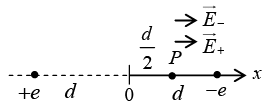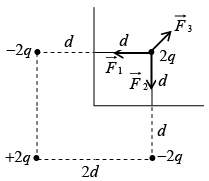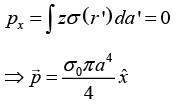Multipole Expansion & Image Problem: Assignment | Electricity & Magnetism - Physics PDF Download
Q.1. A charge (- e) is placed in vacuum at the point (d ,0,0), where d > 0. The region x≤ 0 is filled uniformly with a metal. Find the electric field at the point 
Thus resultant electric field at point P is
Q.2. Consider an axially symmetric static charge distribution of the form,
Find the radial component of the dipole moment due to this charge distribution.
Q.3. Two charges q and 3q are placed along the x -axis in front of a grounded, infinite conducting plane, as shown in the figure. They are located respectively at a distance of 0.5 m and 1.5 m from the plane. Find the force acting on the charge q.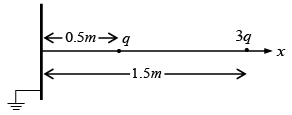
Using method of Images we can draw equivalent figure as shown below:
Q.4. A point charge 2q is placed symmetrically at a distance d from two perpendicularly placed grounded conducting infinite plates as shown in the figure. Find the net force on the charge
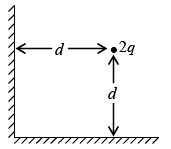
Q.5. Let four point charges q, -q/2, q and -q/2 be placed at the vertices of a square of side 2a. Let another point charge -q be placed at the centre of the square (see the figure).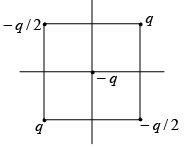
(a) Find the monopole moment.
(b) Find the dipole moment of this configuration.
(c) Let V(r ) be the electrostatic potential at a point P at a distance r>>a from the centre of the square. Then find V(3r)/V(2r).
(a) The monopole moment
(b) The dipole moment of this configuration is
(c)
Q.6. A circular disc of radius a on the xy plane has a surface charge density
σ = σ0r cosθ.
(a) Find the monopole moment.
(b) Find the dipole moment of this configuration.
(a)
(b)
Q.7. A point charge q of mass m is released from rest at a distance d from an infinite grounded conducting plane (ignore gravity).
(a) If the particle reaches a speed u at a distance d/4 from the plane. At what distance from the plane will the particle reach the speed 2u ?
(b) If it takes time t to hit the plane, then what will be time taken by charge when it is released at a distance d/2.
(a)
(b)
Put x = d sin2 θ ⇒ dx = 2d sinθ cosθ dθTime taken by charge when it is released at a distance d /2 is
Q.8. Two point charges, 2q and -q are separated by a distance a, as shown in the figure.
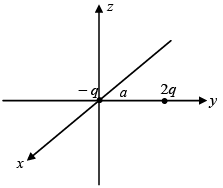 (a) Find the monopole moment.
(a) Find the monopole moment.
(b) Find the dipole moment of this configuration.
(c) Find the approximate potential (in spherical coordinates) at large distance r.
(a) The monopole moment Q = 2q - q = q
(b) The dipole moment of this configuration is
(c) The approximate potential (in spherical coordinates) at large distance r is
Q.9. Charges q, 2q and -3q are placed on the vertices of an equilateral triangle ABC of sides of length a, as shown in the figure. Find the dipole moment of this configuration of charges.
Let coordinates of A is (l, m), then
Q.10. A point charge 2q of mass m is kept at a distance d below a grounded infinite conducting sheet which lies in the xy - plane. There are no charges present anywhere else.
(a) What is the magnitude of electric field at (0, 0, d) ?
(b) Find the work done in placing charge 2q at (0, 0, -d) ?
(c) For what value of d will the charge remains stationary?
(a) The magnitude of electric field at ( 0, 0, d ) is
(b) The work done in placing charge 2q at ( 0, 0, -d ) is
(c) There is attractive force between point charge 2q and grounded conducting sheet that can be calculate from method of images i.e.
|
82 videos|32 docs|22 tests
|
FAQs on Multipole Expansion & Image Problem: Assignment - Electricity & Magnetism - Physics
| 1. What is the multipole expansion in physics? |  |
| 2. How does the multipole expansion relate to the image problem? |  |
| 3. What are some applications of the multipole expansion in physics? |  |
| 4. How is the multipole expansion different from a Taylor series expansion? |  |
| 5. Can the multipole expansion be used to solve real-life engineering problems? |  |

